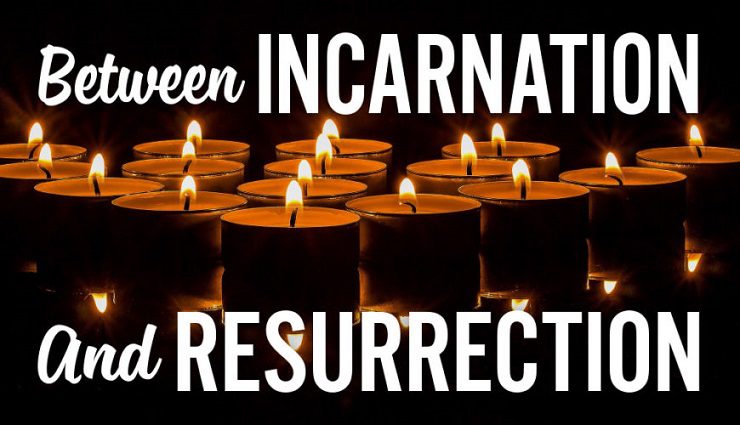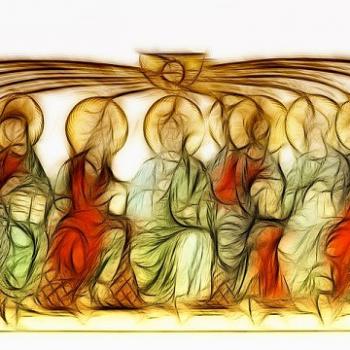A few years ago, a Facebook friend posted a poll on her site. The question was: Which is more meaningful to you—Christmas or Easter? While many respondents commented that their vote was based on which of the two seasons they found more entertaining or less stressful, the most interesting comments were from those who made their choice on what these two holidays mean to them as persons of Christian faith. The underlying faith question is: Which is more central to the Christian faith—the Incarnation or the Resurrection?

I have thought about this for some time now and have a very strong opinion on it—so I thought I’d post a similar poll on my own Facebook site. I asked “For Christian and/or religiously inclined friends: Which is more central to Christianity—Christmas or Easter? In other words, the Incarnation or the Resurrection? This has been debated for centuries—I look forward to your thoughts!”
The results on my friend’s and my own poll, were similar. With over one hundred combined respondents, 76% voted for Easter, 24% for Christmas. With all due respect, the majority is wrong. It’s all about the incarnation.
“What’s the difference between chili con carne and chili con queso?” I asked my freshman students. “One is chili with meat, the other is chili with cheese,” they reply, wanting to know why the hell I would ask this stupid question with an obvious answer in the middle of a class on the Gospel of Luke. As I often do, I gave them a quick lesson in etymology (because, as I have told them many times, words are cool). “The Latin word ‘carnis’ means ‘meat,’” I tell them. “It’s where we get ‘carnal,’ ‘carnivore,’ ‘carnage’ and similar words from. Oh, and it’s also where we get ‘incarnation.’”
That grabs their attention. Although the students on my campus have become more diverse both religiously, racially, and socio-economically over the past decade, the majority of my students are still products of Catholic families and education, for whom the word “incarnation” is a sanitized church word used as a placeholder for the birth of Jesus. But what the doctrine of the Incarnation really means is something astounding and shocking. In becoming human, God chose to “become meat.” And God still does.
“Incarnation” means “to put skin on.’ God’s response to human need, hope, sorrow, desire, pain, joy, and suffering is to wrap the divine up in flesh. On a given day, in a given situation, that incarnated God might be you. It might be me. This is how the divine chooses to be in the world. It’s much more possible to relate to someone with skin on than to a mathematical formula or a logical construct. God is not a Rubik’s Cube. God is a person with skin on.
The incarnation narrative—the story of God becoming flesh—is a direct response to our inherent flaws, imperfections, limitations, and evil. Divine favor and blessing are offered to all of us. And the status of humanity is raised when God inhabits it. I remember singing a Sunday School song that included the lines “we are his hands, we are his feet.” That is the mystery, the scandal, and the beauty of the incarnation story: God entrusts flawed human beings to be the divine in the world.
Instead of looking past the physical and ordinary for what is spiritual or profound, we might do well to remember that the most profound truth of Christianity is that God became flesh, became mundane, became embodied in the world that God created. And this incarnational activity continues in us. We are God’s hands and feet—hands and feet that are made of meat. It may be that an increased focus on our carnality as God in the world is exactly what our age needs. Barbara Brown Taylor writes that:
The last thing any of us needs is more information about God. We need the practice of incarnation, by which God saves the lives of those whose intellectual assent has turned as dry as dust, who have run frighteningly low on the bread of life, who are dying to know more God in their bodies.
I grew up in the same religious world that Barbara Brown Taylor comes from and, like her, was never told in church that my body is good, or that God takes delight in our bodies. But the resurrected Jesus had a body with the marks of death still on it, a body that could be prodded, poked, and still needed to be fed. A body that he took with him back to heaven. God trusted carnality to bring divine love into the world, and God still does. This is worth remembering.
After years of watching bodies being dug out of craters in Manhattan and caves in Afghanistan, after the body counts coming from southeast Asia, Gaza, Iraq, and Syria, and as the number of schools, places of worship, and bars littered with dead bodies from gun violence increases on a weekly basis, we need to remember us that the incarnation ends up with a body—carnis—hanging on a cross.
Simone Weil, who for almost two decades has been the primary focus of my scholarly research and writing, once provocatively wrote in a letter to a Dominican priest that “Hitler could die and return to life again fifty times, but I should still not look upon him as the Son of God. And if the gospel omitted all mention of Christ’s Resurrection, faith would be easier for me. The Cross by itself suffices me.” Weil was an agnostic Jew, a Marxist and social activist, who in her late twenties, just a few years before her premature death at age 34, had a series of mystical experiences that convinced her of the reality of something greater than herself.
Most of her closest friends and acquaintances were Christians, so she sought to work out the implications of her experiences within a Christian framework—although she never converted to Christianity. I’m not willing to go so far as to say that the Resurrection is dispensable, but I resonate with Weil’s insight that the indispensable heart of Christianity is one of divine love so great that God chooses to become human, to be with us in our humanity in the most intimate expression of solidarity and love. The incarnation that we celebrate during the Christmas season is where that was established.
At St. John’s University and Abbey in Collegeville, Minnesota, Benedictine priest Godfrey Dieckmann was a rock star. He and his mentor, Fr. Virgil Michael, were perhaps more responsible for liturgical reform and renewal in the Catholic Church than any other individuals. When I was a resident scholar at an ecumenical institute at St. John’s in the Spring 2009 semester, I heard many Godfrey Dieckmann stories—his wit as well as his temper were legendary. My favorite of these stories might be apocryphal, but I heard it so often that I suspect it is true.
One evening while eating with colleagues and students in the student dining room, Dieckmann got involved in a spirited conversation about the heart of Christian theology and life. He startled those at his table as well as those within earshot by slamming his hand on the table and shouting “It’s not the Resurrection, god-dammit! It’s the Incarnation!” As students, stunned into silence, slipped away he added “But we don’t believe it. We don’t believe that we are invited to become the very life of God.” The Christmas season that we are celebrating—that is incubating in each of us—is the moment of salvation as God enters time, history, and each of us.













